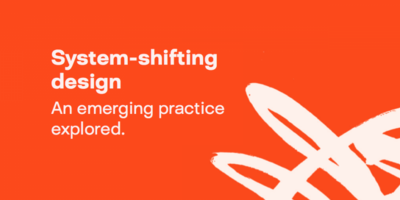Designing better beginnings for families

In 2015, Staffordshire County Council (SCC) applied to be part of LGA's and Design Council's Design in the Public Sector programme. The council was investigating the development of community-based solutions to support vulnerable families with babies and pre-school-age children, where there are known lower-level risk factors but where earlier and less formalised intervention has the potential to have a significant long-term impact.
The challenge
Despite making up just 20 per cent of Staffordshire's population under 19 years of age, children under five represent 40-45 per cent of children in the Child Protection (CP) population. In the majority of families, the issues of concern arise from neglect and chronically poor parenting.
Staffordshire County Council is committed to finding a more effective way to identify vulnerable pre-school children earlier and to engage their families with effective support, by way of practical help, expanded support networks and empowering parenting experiences.
During 2014, Staffordshire Observatory undertook extensive research as part of SCC’s ‘Best Start’ transformation. This identified that less than a quarter of 0-5s in the 0-30 per cent most deprived LSOAs (lower-layer super output areas) engaged in universal and early intervention services at the Children Centres across Staffordshire. In Lichfield, the engagement was lowest of the eight districts, at 13 per cent.
On the back of that research, a decision to reshape Children’s Centre provisions across Staffordshire was made in January 2015. This shift in resource would leave Burntwood, located around four miles west of Lichfield and a population of approximately 30,000, with no local children’s centre.
Born initially out of a campaign group, and with the help of officers, elected members and cross-party support, a group of local mothers were inspired to create a new organisation, called Spark CIC, to take over the running of two children’s centres in the town. The SCC applied to be a part of the Design in the Public Sector programme with the aim of shaping an effective solution and enabling imaginative and confident co-production with families and communities themselves.
Engagement and action
As well as county council members, the team who took part in the workshops involved a director from Spark CIC. During the opening two days of engagement, all members of the challenge team had the chance to identify the challenges ahead. The design tools used enabled the team to reflect on those challenges from each other’s perspective, and develop iterations of the design challenge itself.
The theory that building relationships between families would enable more resilient families and communities was to be the focus of this action research programme.
Wayne Mortiboys, District Commissioning Lead, Staffordshire County Council
Wayne Mortiboys, District Commissioning Lead at Staffordshire County Council, explained what reframing the challenge did for the team’s project: “We soon realised the impact the council was trying to make was as much – if not more – on the parents of young children in Burntwood. Success would take the shape of better parenting, regular engagement with other families in similar situations, facing similar challenges or, better still, having survived such challenges and imparting their learning through peer support. The theory that building relationships between families would enable more resilient families and communities was to be the focus of this action research programme.”
Results
Success would mean a thriving, financially stable community organisation creating an offer that engaged with ‘at risk’ families at an early child development stage and continued through their most formative years with a blended offer which embraced all families.
The team were able to agree a broader definition of ‘at risk’ families than previously documented (living within 0-30 per cent deprived LSOA’s); to include young parents, single parents and those with early signs of having Special Educational Needs. Following day two of the workshop, the group agreed on a revised challenge: ‘Brighter beginnings for families through community support’.
The council's investment would need to reflect on 'at risk' families and embrace alternative and creative ways to increase Spark CIC's revenue streams.
This broader statement enabled both parties to agree to new ways of working with benefits:
- From the county council’s perspective, it acknowledged that the best environment for children to be engaged in would not just consist of children from deprived backgrounds. The tools and techniques used also helped the officers be clear with how their investment would need to reflect and focus on ‘at risk’ families and also embrace alternative and creative ways to increase Spark CIC's revenue streams.
- From Spark’s perspective, it helped their understanding of how Staffordshire could directly finance sustained engagement of those considered ‘at risk’ on a transactional basis, rather than through more traditional grants.
One of the most useful techniques that the team came across for the first time was around engagement with ‘super users’ at one end of the scale and those who were ‘disengaged’ at the other, rather than focusing on the average participant/recipient of activities and services. As a result, much richer data was gathered by the team that could be used to design a more engaging offer for families.
The insights highlighted that the Children’s Centre free pass scheme the council had developed to improve access for low-income families had actually created a barrier to engagement by those it most wanted to help, due to the stigma attached to having to present their card at the beginning of each session.
Spark CIC has since decided to introduce a membership card at their ‘Spark Centres’ for all members. They will also seek to maximise the benefits to all families through potential commercial discounts through local businesses. SCC has agreed to fund a data management system for Spark to enable them to maintain registers of all activities and to better understand their membership habits, something which was impossible using the current paper-based systems.
The other main product of the programme has been the creation of a process to financially incentivise Spark to engage ‘at risk’ families. The outputs from the data management system will become the backing sheets to support monthly invoices, whereby SCC reimburses Spark for the ‘lost’ revenue from families who would previously have been entitled to a free pass.
Analysing the research
Using data from the first 1,100 families involved in Staffordshire’s Troubled Families programme (known locally as Building Resilient Families and Communities), thematic and geographic areas of risk have been identified. These have been agreed as the risk areas and Spark receives a £3 per-session incentive to engage with families who meet these criteria. This is done confidentially and does not require the family to identify themselves to other group members as being ‘at risk’.
Data from the summer term of 2016 was the first to be used in this way and has resulted in a much welcomed payment of £1,092. The important distinction here is that rather than being a grant from the local authority, the arrangement is now transactional and ensures that the county council is only paying the incentive to families who are, as the research suggests, most likely to be ‘at risk’.
In numerical terms, the payment equates to support for approximately one third of children who attended sessions during the term.
In numerical terms, the payment equates to support for 78 qualifying children, who attended 364 sessions over the 3-month period or approximately one third of children who attended sessions during the term. It is important to both parties that sessions consist of a good mix of families so that those seeking it can be supported by the community on a peer-to-peer basis and also in friendship groups which develop and last beyond the Spark sessions.
Staffordshire County Council is also funding 2,000 leaflets which volunteers from Spark will deliver to all properties within the geographical target area, with the hope this will identify additional ‘hidden’ families who are ‘at risk’ and encourage them to participate in future activities.
Data from the autumn term will be entered into the data management system by Spark CIC volunteers, which will lead to a further payment. It is hoped that, once Spark CIC system is proved successful, the data input will become more regular and will lead to a more steady revenue stream for Spark and a more up to date data set.
Mortiboys explained the results: “The beauty of the agreed solution is that out of those attending – through use of a membership card for all – those harder to engage families are unidentifiable to the other participants, thereby reducing stigmatisation and increasing their participation. The tools and techniques learned by both the council and Spark during the DiPS programme really helped both parties identify what was most important to them and to create a win-win solution.”
This approach will be piloted over a six-month period with a laminated paper membership card meaning engagement levels can be recorded and analysed. If this pilot shows that engagement levels with ‘at risk’ families has risen, a further investment is available from SCC to prototype a credit card-style electronic swipe card which will reduce the need to manually data punch registers.
If this is successful it then has the potential to be rolled out across Staffordshire for other community organisations to be financially rewarded and incentivized, creating additional activities for families ‘at risk’. This outcome would enable SCC to demonstrate an increase in reach data for families across a wider area and sustainable funding streams for community organisations delivering shared SCC outcomes.
Subscribe to our newsletter
Want to keep up with the latest from the Design Council?

